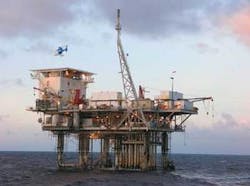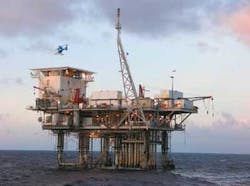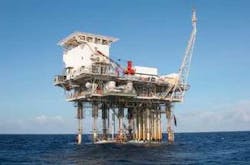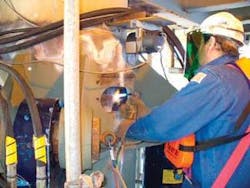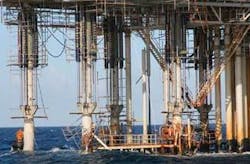Existing platforms raised to increase storm clearance
A Devon Energy-operated platform with 44 people on board in the Eugene Island 330 field in the Gulf of Mexico was raised 4.25 m (14 ft) by 32 synchronously controlled hydraulic cylinders. The eight-leg platform, Eugene Island 330C, in 76 m (250 ft) of water originally was installed in the early 1970s. In 2005, Hurricane Rita passed through the field causing significant damage to EI 330C and claimed connecting platform EI 330S. In order to prevent repeated damage from future storms, EI 330C and neighboring platform EI 330B, which had also suffered significant damage from the hurricane, Devon teamed with Versabar to raise both platforms.
Due to the size of the hurricanes during the 2005 season and resulting uncertainty in future requalification metocean criteria, Devon Energy decided to have the platforms qualified to meet API RP 2A, Section 17, A-I criteria, even though the platforms were classified as A-2. Analysis showed that by raising the decks 4.25 m (14 ft), the effects of wave-in-deck loading would be removed and a comfortable air gap established. Analysis also showed that the additional leg movements attributable to increased platform leg length would not affect the structural integrity of the platform. The deck-raising was sanctioned by Devon and partners in May 2006, with raising operations for the two decks completed by November.
null
System design
A key design element of the deck-raising system was placing split sleeves around the existing legs. This served to contain the deck legs during the initial cutting, to provide lateral stability for the topsides during jacking, and to provide the permanent leg extension sections for support of the topsides at the new elevation. The split sleeves were installed around each deck leg after cutting approximately 60% of the circumference in four equal quadrants. Following the installation of all the sleeves and immediately prior to the raising operations, the remaining 40% of the deck legs were cut through windows in the sleeves.
After jacking was completed, a pin specified to withstand storm loads in API A-2 criteria was inserted through the split sleeve and the leg to provide a storm-safe condition after cutting the deck legs but prior to welding. This design feature enabled most of the work prior to jacking to be completed during the 2006 hurricane season.
The platform-raising system was designed with two control modes - synchronous and manual. Both control modes keep the relative leg displacements within 25 mm (1 in.) to avoid overstressing the deck members. Synchronous is the primary control mode. A computer system sends signals to the flow control valves for all legs at the direction of one operator. The synchronous controls are on a main control console that also houses two monitors that show all aspects of the platform raising, including leg displacements, cylinder pressures, and hydraulic oil temperatures. In manual mode, operators at independent consoles adjust the flow control valves for each leg. The consoles contain displays which show leg displacements. The only variable used to control the flow of oil to each leg during the platform raising is the displacement of each leg. That displacement is measured by transducers mounted to each leg.
Testing
Prior to raising EI 330C, the controls and split-sleeve design were tested at Versabar’s Houston, Texas, yard. A structure with four legs identical to the offshore platform’s legs was built, and steel weights were added asymmetrically on top so each leg would support a different load with a magnitude similar to the actual offshore platform. The total weight lifted in the test was 742 metric tons (818 tons) with the most heavily loaded leg supporting about 298 metric tons (328 tons). Based on analysis, the most heavily loaded leg offshore was expected to have approximately the same load. On Thursday, Sept. 28, in Versabar’s yard, the test raised 742 metric tons (818 tons) from an elevation of 12 m (38 ft) to 16 m (52 ft) in less than one hour while keeping all leg displacements within 25 mm (1 in.) of one another.
Failsafe
In addition to completing full system testing prior to mobilizing offshore, several redundancies were designed into the system to mitigate potential problems offshore. To ensure that a displacement transducer failure would not hinder the raising process, each leg was fitted with two transducers. If the primary had failed, the controls would have switched to the secondary transducer without interrupting the lift. Equally spaced around each leg are four, 236-metric ton (260-ton) capacity hydraulic cylinders sized so their load is approximately 30-40% of their maximum capacity while loading offshore. This low level of utilization allows for one or two cylinders on a leg to be unpinned should they fail and still be able to continue raising the platform. In addition to the redundant control systems, spare equipment including two cylinders, two power units, two manual control consoles with hydraulic valves, and multiple hoses and fittings also were held on the platform.
null
The lift
By the third week in October, all the equipment was installed on EI 330C. Raising began on the afternoon of Oct. 18. After completing an equipment checklist and removing the pins from the legs, the cylinders on all the legs were slowly extended until each had a pressure reading of 2 MPa (300 psi). Then, the circumferential cuts in the legs were completed through access holes in the extension sleeves. The platform was raised 25 mm (1 in.), then 152 mm (6 in.) to confirm the synchronous controls were working properly and there were no interferences. The platform was estimated to weigh 1,451 metric tons (1,600 tons) and was calculated from the hydraulic pressure readings of the cylinders to be 1,724 metric tons (1,900 tons), including the jacking equipment. At this point, the platform was lowered, and the pins reinserted into the legs for the night.
On Oct. 19, the pins were removed. Jacking began at 8:15 a.m. After the initial upward movement, the only indication the platform was moving came by looking at the legs. On top of the control console were two monitors displaying views from cameras oriented toward the bottom hole in the extension sleeves on each leg. As the platform neared its final lift height, the hole in the platform leg could be seen starting to align with the hole in the extension sleeve. At 9:15 a.m., after rising 4.27 m (14 ft), the platform came to a gentle stop, and the pin hole in each leg was independently oriented using the view from the cameras. One hour later, all the pins were installed in the legs, and the platform was lowered onto the pins. During the entire lift, the pressure on the legs varied by no more than 3.5 MPa (500 psi), which corresponds to 82 metric tons (90 tons). During the last 1.5 m (5 ft) of the lift, one leg carried no load at all. The overall force required to raise the platform varied between 1,724 metric tons (1,900 tons) and 1,783 metric tons (1,965 tons) during the one-hour lift. Immediately after the lift, the cylinders were retracted so that the weld-out of the leg sleeves to the deck legs could begin. Within two days, all the jacking equipment was removed from the platform with the exception of the cylinders which took longer due to weather.
While EI 330C was being raised, EI 330B was being prepared for lift. Three weeks after the first successful platform lift of its kind in the GoM, Devon Energy and Versabar repeated the success by raising EI 330B 4.27 m (14 ft) on Nov. 10, 2006.
Paul Van Kirk, Versabar Inc.
Mark Day, Devon Energy Corp.
